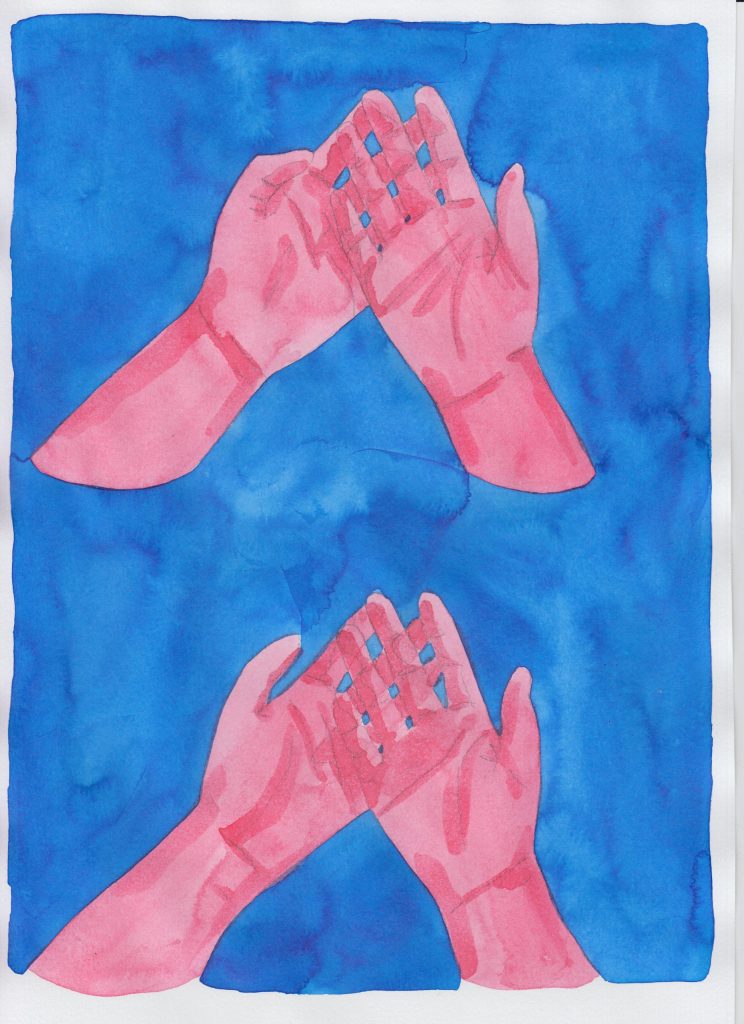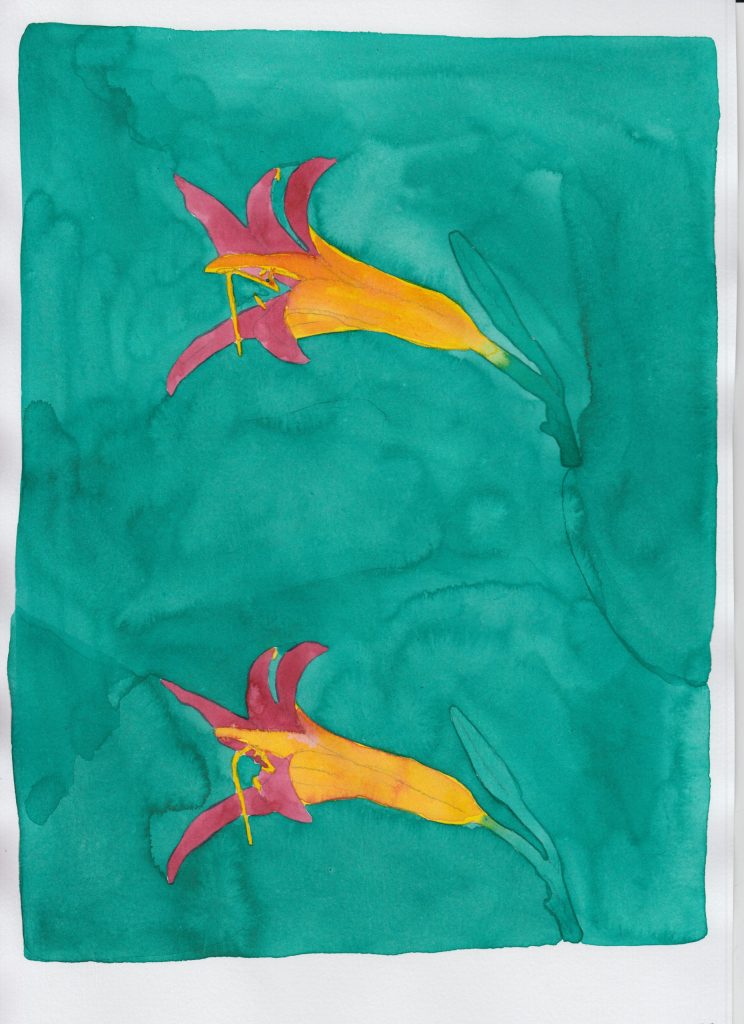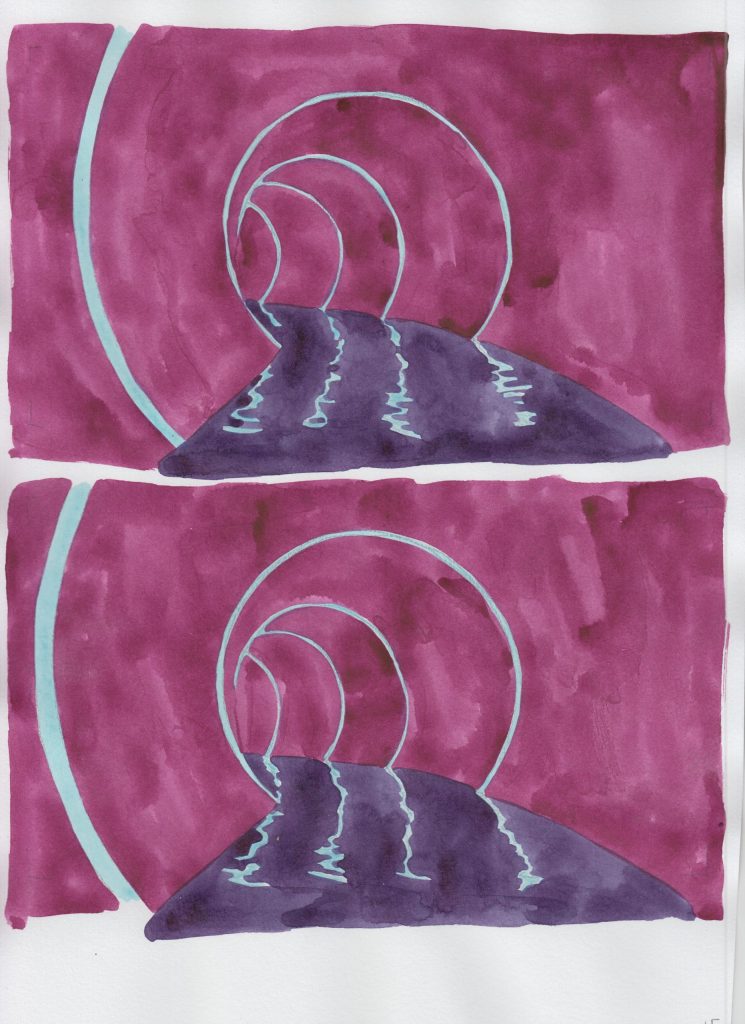Katie Armstrong at The Armory Show (and Beyond)

In the first week of March, only days before New York would begin to shut down, FRONTRUNNER saw the incredible work on display at The Armory Show 2020. In a maze of white boxes, amid pop-up galleries full of paintings, sculptures, neon signs, and performance pieces…a single, small iPad hung from a wall display of EIGEN+ART (Berlin/Leizpig). On it was the latest piece from Brooklyn-based artist Katie Armstrong, a multi-disciplinary animator who hand-paints the frames, writes the poetry, sings the songs, and plays the music which all comprise her video works. As I put on a pair of headphones, the busy warehouse along the Hudson fell away. Trance-like, I watched i, i, i (the spiral), a short meditation on family, connection, and what people inherit from each other. The artist’s soft voice, almost a whisper, recites a poem:
You said I touch the softest part of you /
I look at my hands and think /
Maybe what you are is what’s been done to you /
But who you are is what you do /
The piece is awash in vibrant pastels, which, due to Armstrong’s watercolor painting of the frames, wave and ripple across the screen. The images echo the theme of the poem: a tunnel which goes on forever, a chain that keeps pulling upward, a flock of birds flapping their wings against a seemingly unmoving sky. FRONTRUNNER spoke with Armstrong by phone from her apartment in Brooklyn, the epicenter of the COVID-19 pandemic in the US, about the piece, her process, and the way interpersonal relationships can have lasting effects on ourselves and on the world around us.

release 17 (2020)
Graphite, watercolour and acrylic dye on paper
30.5 x 21.6 cm
Courtesy of the artist and EIGEN + ART Lab (Berlin)
What was the inspiration for i, i, i (the spiral)? What is it about?
I guess a good place to start is process. That’s sort of the place that all of my work starts. I make traditional, hand-drawn animation, which is a very slow, slow process. It’s a process that takes a lot of repetitive, cyclical, kind of, meditative drawing and redrawing and tracing and looping over what I’ve done before. [It] is something I’ve been doing since I started making animations, but also since I started becoming aware that I’m a person who needs to sort of make things in order to process what I experience as a person in the world. So, every piece is the result of me trying to feel my way through a particular moment in time.
i, i, i, (the spiral), is the culmination of a collection of thoughts and feelings that I’ve been sitting with and working through for the past few years. I would say the piece itself took about four months to animate, but I have a practice of writing every day. Every morning I start off by writing and I work with a lot of fragments. I write in fragments, I draw in fragments, I record music in fragments. Although the animation part took a few months – the poetry, the writing I was looking at and working on – I want to say I started in 2016…the earliest pieces of this.
I had been living in Berlin in Germany for a couple of years prior, and my dad was very ill with cancer. In September of 2016 he took a very, very sharp turn. I kind of had to pack up in the middle of the night, and fly home quite quickly. He ended up passing away within two weeks. Then the election happened. I think it’s been a very challenging time for so many of us these past handful of years. In this piece, I’m grappling with so many things that it’s hard – it took so much time for me to try to distill it into the poetry. I think it’s so difficult for me to talk about, and that’s kind of why I turned to poetry. The material that we work with in poems, it’s this material that we use all the time to communicate. But in poems, we can break open words or stitch words together with other words in a way that doesn’t necessarily have to make sense – in the way that I’m trying to make sense to you right now as I speak. Instead, a poem can kind of make sense to our emotions and our feelings. Words can be rearranged and reformed so that they can touch us in these places that are hard to articulate.
It’s interesting to hear about what you were going through. Seeing the piece, it felt like it was about family, or the relationship between people across generations. And it also feels very preoccupied with the nature of cycles and recurrence. Could you talk a little bit more about those elements?
Oh, my heart just started to pound, even just then, hearing you reflect that back to me because you really picked up on the soul of the piece. It really is about family, about connection between people, about the way that we pass things down to one another through time. I think when a death in the family happens, it can kick up a lot of old traumas that exist that have been sort of put into a box and stored deep down. For me, what my dad’s death kicked up was some trauma that happened to me when I was a kid. I won’t go too deeply into that, but I experienced some sexual abuse as a child. So, much of my identity was created on top of this foundation of a secrecy and pain, a secret pain. It took me a really long time to deal with what had happened. In fact, I think in some ways when I moved to a different country – when I was living in Germany – it was really only then that I think I felt safe enough to begin even admitting to myself what had happened. I was already digging into that work when I was living in Berlin, and there was a period of time when I really thought, “I don’t know if I’ll even ever be able to move back to the US.”

bloom and wilt 36 (2020)
Graphite, watercolour and acrylic dye on paper
30.5 x 21.6 cm
Courtesy of the artist and EIGEN + ART Lab (Berlin)
I wasn’t sure if I would be able to be close with my family. I didn’t know how to tell my family, I didn’t want to cause pain. But, I think when my dad got sick, it really pulled me back to the US. Looking at it now, I’m really grateful that it did because I was able to be open and honest with my family, and we’re in a much different place with that now. But as I look around me at the world and at other people and the people who have power that are causing pain to other people, like the President, I think (like so many of us) I’m trying to make sense of: how does someone make these decisions? What has happened that has caused this? It’s heartbreaking, because when you think about a kid – just a new person in the world – when we’re small, our families, our extended families, the network of people we’re around, that is the network that teaches us how to be. The foundation of who we are is formed at that time and it can have just such dire consequences on the world.
You work in both hand-drawn animation, and in watercolor paint in your individual frames. What is it about that style that you like?
I love to see the artist’s hand. That’s just kind of across the board, in every medium.
I love jankiness. I love things to be a little runny and out of control.
With my work, I love working with watercolor because it feels like the watercolor has plans that I don’t know about. I can let colors bleed together. I can let the water interact with the pigments and dry in these puddles. I like to surrender as much control as I can to the paint. It’s sort of a collaboration between the materials and myself and my body, and I want that collaboration to be felt. I want it to be visual. In the paintings, I feel like you can see my body and my efforts, but also in the audio, too. I like to follow that same kind of philosophy. In this particular piece, I don’t do any singing, but in my other work, often it’s very focused on singing, on creating tones and layers with my voice. In that, too, I record from my bed a lot of the time. I make these recordings in GarageBand. I don’t have very fancy equipment. I like [you] to be able to hear the room, my voice in the room, in the space. I want it to feel really personal and, in a way, really private. Also, really inviting other people into this, this private space. Not just my private space, but inviting people to kind of enter into their own private space with the work. Letting them see a little key to unlock a door, and inside that, you can spend some time reconnecting with [themselves].
I think with video, sometimes, there can be this barrier. Especially, given that you’re presenting in a gallery space where all this other art is around that is considered to be more traditionally tactile. It’s quite a feat to make a video piece, as you’ve done, that feels as alive as other art that is more physical, so to speak.
I’m also really inspired by William Kentridge, who makes these animations that are…you can feel like the charcoal dust flying around. They’re so handmade-looking. I’ve always been really attracted to that handmade quality. Even as a kid when I was in high school, seeing films by Michel Gondry or something, where he was using these really practical effects to create this, there’s like a playfulness in it. A playfulness and an invitation of like, “Look, you can see my hand in this.” That also means that you have hands that you can try and create something with, there’s something that feels accessible.
https://www.instagram.com/p/B9ZaDy3lidb/
That was going to be my next question, actually. You work in so many different mediums. I’m curious about your inspirations in all facets of your work – inspirations in the prose sense, or the music sense, too.
So many, but I’ll start with Fiona Apple, because I just read a really great interview with her, it was [in] The New Yorker, I think. I love Fiona Apple so much and she was someone I listened to when I was a kid. So, my dad was a musician and I grew up in a very musical household. My brother is a drummer and my mom has always been a really creative person. My dad got me a Fiona Apple CD, Tidal. That made such a deep, deep impact on me because she was so young at the time (I think she was like 16 or 17, maybe), but she was writing these songs that were about being raped, she was writing these songs grappling with these intense feelings. She was accessing, just, this power inside of herself, in creating these gorgeous songs. And that was just, that was huge for me as a kid. I think she is the artist I’ve loved for the longest time, I think.
Also, I love Miranda July. She’s someone, she’s an artist who really straddles film, prose, theater, and performance, and she has inspired me. I have been working more with performance over the past few years, like projecting animations, using a loop pedal and a little amplifier and creating these spaces that are like part-ritual, part-poetry reading, part-dance, improvisational dance, part-singing. I think Miranda July is someone who let me know that I didn’t have to just be one thing.
Patti Smith is, it’s a big one. Her approach to making music, it comes from this place of commitment to wanting to express something in the most effective way. She wasn’t trained as a musician, and I wasn’t either. Even though I think my dad really wanted me to learn guitar, I always have to just teach myself how to do something and I have to come about it in my own way. My dad was like a guitar virtuoso, so I think [that] was a little intimidating. I found my own way to music, in the end, and to animating – I didn’t study animation or anything. I think Patti Smith’s spirit of taking her poems and deciding that the poetry readings she was going to were too boring – she wanted to find a way to make the words feel alive and to cut through to really make it inside of the people who were listening.
What was it like to show your work at The Armory Show?
It was a whole cocktail of things. I’ve been going to The Armory to see it almost every year since I moved to the city for art school. I’ve been going to The Armory for a long time. So, there was something really surreal about having my work there. I always feel extremely grateful for any chance I have to share what I make with other people. It’s really scary and hard to share it.

tunnel 15 (2020)
Graphite, watercolour and acrylic dye on paper
30.5 x 21.6 cm
Courtesy of the artist and EIGEN + ART Lab (Berlin)
I feel extremely lucky and so much of this is luck. I have this gallery, EIGEN+ART, who have really supported my work for a long time. They lovingly pushed me to continue challenging myself and to continue sharing what I do with other people. So, I feel really, really grateful for that.
I never feel very natural in those kinds of situations where I am in a white cube space in an art fair. There’s definitely this tension, because I just feel like this soft, squishy animal that has a lot of feelings and wants to share them and see if other people have those feelings too. I really want to feel connected to other people. But art fairs can be so overwhelming. There’s this whole matter of the art being a thing that’s being sold, right? Attaching prices to art, it’s still something I don’t quite – it’s hard for me to wrap my head around. It doesn’t always feel like my natural habitat. Yet, I do need to interact with money in order to exist in the world, as it is right now. And so, I do, I feel a tremendous amount of, again, gratitude for having the opportunity to try to make a living off this strange thing that I do.